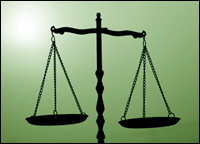Dear Umbra,
It seems everyone is getting leather upholstery in their cars and on their couches these days. Where is it coming from — the same cows that are being slaughtered for hamburgers, or special cows that are raised for their hides? What is the environmental impact of all this luxurious leather?
Sharon
Collegeville, Penn.
Dearest Sharon,
Hides are a byproduct of food-related animal processing. Cattle are large, expensive animals, and using every last piece of a slaughtered cow yields the best payoff for all the labor and financial investment. Note, though, that not all leather is from bovine animals; you can also get yer leather from goats, sheep, snakes, deer, and such.

Is this comfy leather chair as
soft on the environment as
it is on your backside?
Almost half of all U.S. cattle hides travel overseas for tanning and processing into leather. But of those hides processed in the United States, about 50 percent end up as car upholstery. Apparently, U.S. auto-upholstery tanneries continue to be among the very best. However, the rest of the North American hide-processing industry has lost ground to other countries with cheaper labor and lower environmental standards.
That matters, because the ecological impact of leather manufacture depends on the environmental safeguards at manufacturing locations. Here in the U.S., our environmental standards are relatively strict; in developing countries, less so. Small mom-and-pop tanneries may have less effluent relative to their locality, but large McTanneries may have the funds to mitigate their community impacts. I assume you’re familiar with the broader environmental harm caused by Too Many Cows, so all I’ll do here is broadly discuss the potential problems represented by tanning. About which, let me first just say: yuck. Stop reading now if you are squeamish.
Tanning is the process of turning part of a formerly living animal into a non-rotting, soft, durable textile. Hair and flesh are removed, edges are trimmed, and the remaining skin is cured, stretched, and dried. Some steps in the process can be achieved physically, while others are achieved chemically. Both physical parts of the cow and chemicals used in the tanning process create effluent — defined, for our purposes today, as waste mixed with water that flows out of a water-based manufacturing process.
One of the biggest environmental concerns is how effluents from tanneries affect surface water and local air quality. Tannery effluent can include “solids” (i.e., useless parts of the ex-animal suspended in water), which put a strain on water-treatment systems and, if left undisturbed, can form a skin on still water bodies, choking aquatic life forms. Also, oils and grease from the animal fat can clog treatment systems and generally gum up everything in sight.
Other problems: Organic material and some chemicals left over from the tanning process may degrade in water but engage a vast amount of oxygen-gobbling bacteria in the process, robbing normal aquatic organisms of their own oxygen supply and resulting in anaerobic conditions in waterways. (Anaerobic conditions are a potential outcome of almost all effluent components, either through this “oxygen demand” or through nitrification.) Sulfides are present in effluent and may break down into hydrogen sulfide, a toxic and potentially deadly gas. Various neutral salts can change the salinity, hospitality to life, and drinkability of water. Chromium and aluminum metals are often used in tanning and are known to be toxic.
In short, tanning techniques hold many potential dangers for water-dependant life forms. I want to emphasize again: the actual damage is highly variable, depending on the particular tanning process and local environmental controls. The only definite conclusion I would draw is that luxury automobile owners aren’t in the habit of thinking too much about the genesis of their leather seats.
Upholsterly,
Umbra



